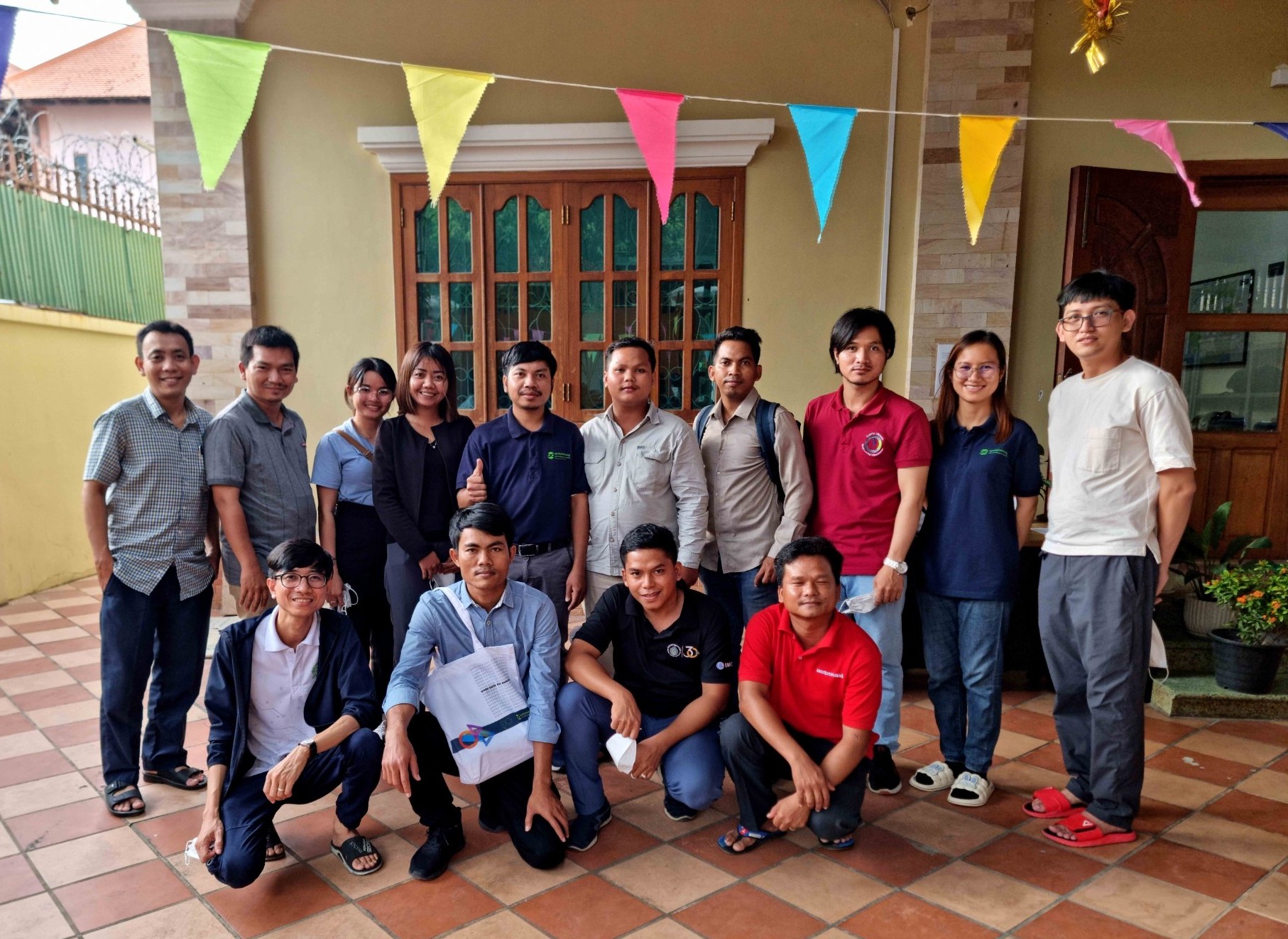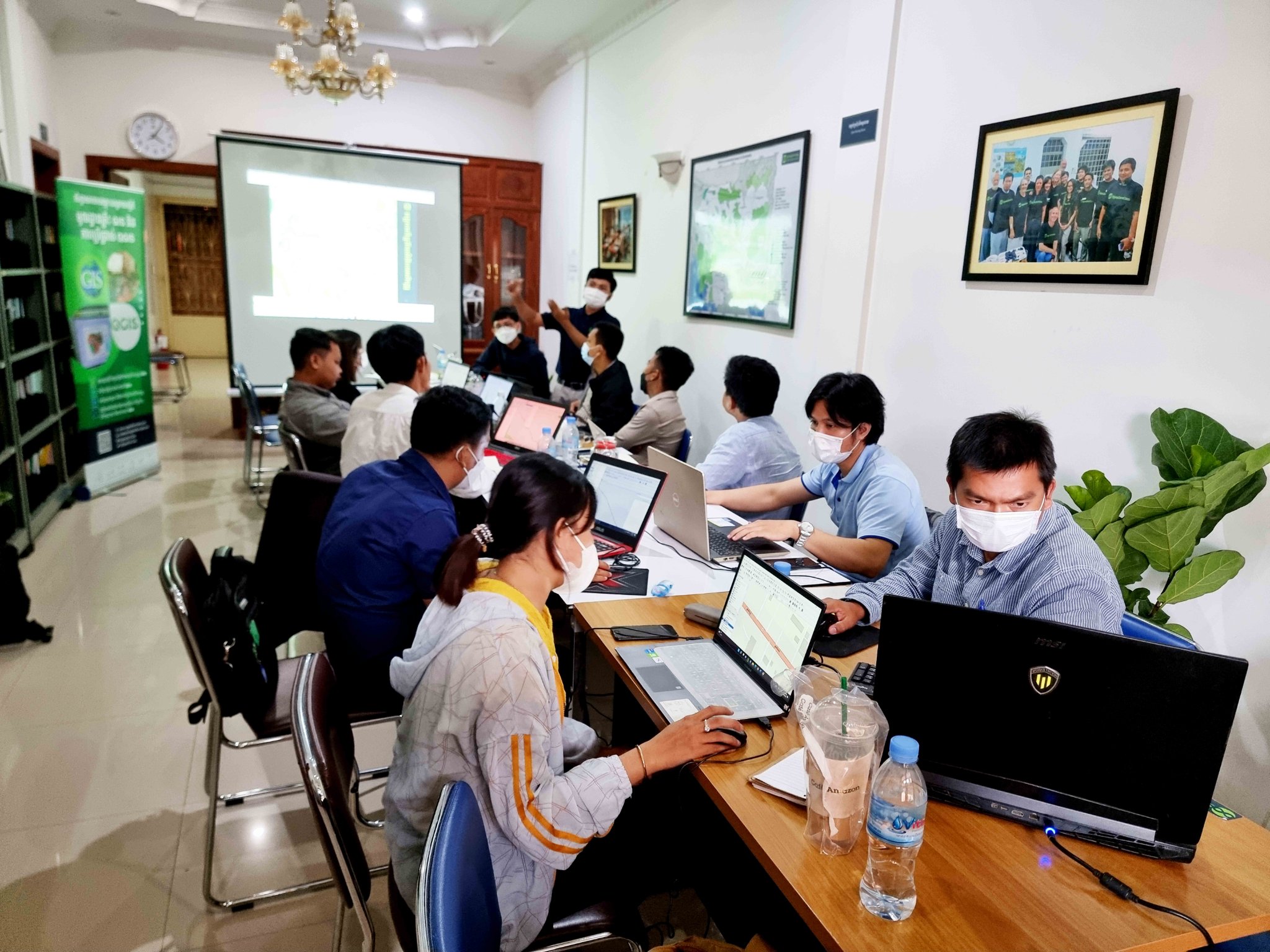សិក្ខាសាលាបណ្តុះបណ្តាលស្តីពីមូលដ្ឋានគ្រឹះនៃ QGIS ទាក់ទាញការចាប់អារម្មណ៍ពីសាធារណជន
QGIS គឺជាកម្មវិធីប្រព័ន្ធព័ត៌មានភូមិសាស្ត្រដ៏មានសារៈប្រយោជន៍សម្រាប់ការមើល និងការវិភាគផែនទីភូមិសាស្ត្រ ដែលអាចប្រើប្រាស់បានដោយមិនគិតថ្លៃ។ វាក៏ជាកម្មវិធីបើកទូលាយដែលពឹងផ្អែកលើអ្នកជំនាញ និងអ្នកប្រើប្រាស់មកពីជុំវិញពិភពលោក។ QGIS មានមុខងារជាច្រើនដែលទាក់ទងនឹងការផលិតផែនទី វាធ្វើការទៅលើការមើលទិន្នន័យ រុករកទិន្នន័យ និងរៀបចំផែនទី បង្កើត កែសម្រួល គ្រប់គ្រង និងនាំចេញទិន្នន័យ វិភាគទិន្នន័យ បោះពុម្ពផែនទីនៅលើអ៊ីនធឺណិតជាដើម។ អង្គការទិន្នន័យអំពីការអភិវឌ្ឍ (ODC) គឺជាស្ថាប័នជំនាញដែលមានបទពិសោធន៍ច្រើនក្នុងការផលិតផែនទី ហើយការបណ្តុះបណ្តាលលើប្រព័ន្ធព័ត៌មានភូមិសាស្ត្រ(GIS)បានក្លាយជាប្រធានបទដ៏គួរឱ្យចាប់អារម្មណ៍មួយនៅក្នុងអង្គការ ODC។
ដូចនេះ នៅថ្ងៃទី ១ និងទី ២ ខែសីហា ឆ្នាំ២០២២ អង្គការ ODC បានធ្វើសិក្ខាសាលាបណ្តុះបណ្តាលស្តីពីមេរៀនទូទៅ GIS និងមូលដ្ឋានគ្រឹះនៃ កម្មវិធីប្រព័ន្ធព័ត៌មានភូមិសាស្ត្រ (QGIS)។ សិក្ខាសាលានេះមានគោលបំណងផ្តល់ចំណេះដឹងទូទៅអំពី GIS និងការប្រើប្រាស់កម្មវិធី QGIS សម្រាប់ការប្រមូលទិន្នន័យ ការគ្រប់គ្រងទិន្នន័យ និងការធ្វើផែនទីដោយយកបរិស្ថាន ដីធ្លី និងធនធានធម្មជាតិជាប្រធានបទនៃសិក្ខាសាលា។
ក្នុងអំឡុងពេលនៃការផ្សព្វផ្សាយពីសិក្ខាសាលានេះ មានអ្នកចុះឈ្មោះចូលរួមចំនួន ១១១ នាក់ ប៉ុន្តែមានតែសិក្ខាកាមចំនួន ១០ នាក់ (ស្រី ២ នាក់) ប៉ុណ្ណោះដែលត្រូវបានជ្រើសរើស ដោយសារគោលបំណងសំខាន់នៃសិក្ខាសាលាគឺផ្តោតទៅលើការធ្វើឱ្យអ្នកចូលរួមស្គាល់ច្បាស់ និងបានអនុវត្តកម្មវិធី QGIS ជាក់ស្តែងភ្លាមៗ។ សិក្ខាកាមទាំង ១០ នាក់នេះ មកពីអង្គការមិនមែនរដ្ឋាភិបាល (NGOs) មន្ត្រីរដ្ឋាភិបាល និស្សិតសាកលវិទ្យាល័យ សាស្ត្រាចារ្យ និងបុគ្គលិកនៃក្រុមហ៊ុនឯកជនដែលកំពុងធ្វើការយ៉ាងសកម្មលើដីធ្លី បរិស្ថាន និងធនធានធម្មជាតិ។
ថ្ងៃទី ១ នៃវគ្គបណ្តុះបណ្តាលនេះ លោក ឡុច កល្យាណ អ្នកស្រាវជ្រាវទិន្នន័យ និងឯកទេសប្រព័ន្ធព័ត៌មានភូមិសាស្ត្រ (GIS) បានធ្វើការស្វាគមន៍សិក្ខាកាម និងណែនាំពួកគេពីសារៈសំខាន់នៃសិក្ខាសាលាបណ្តុះបណ្តាលនេះ។ បន្ទាប់មកមានការចាប់ផ្តើមសំណេះសំណាលគ្នារវាងអ្នកចូលរួម និងក្រុមការងារ ODC ដើម្បីស្គាល់គ្នាឱ្យបានច្បាស់មុនចាប់ផ្តើមបណ្តុះបណ្តាល។ អ្នកចូលរួមទាំងអស់តម្រូវឱ្យធ្វើតេស្តសាកល្បងមុនក្នុងគោលបំណងវាស់ស្ទង់ចំណេះដឹងដែលមានស្រាប់របស់ពួកគេ។
នៅថ្ងៃដដែលនោះ លោក វង្ស ពិសិដ្ឋ មន្ត្រីជាន់ខ្ពស់ផ្នែកស្រាវជ្រាវទិន្នន័យ និងប្រព័ន្ធព័ត៌មានភូមិសាស្ត្រ (GIS) បានប្រើប្រាស់ជំនាញ និងចំណេះដឹងវិជ្ជាជីវៈរបស់ខ្លួន ចែករំលែកអំពីលក្ខណៈបច្ចេកទេស និងការយល់ដឹងស៊ីជម្រៅអំពី GIS ។ មេរៀនទាំងនោះបានពង្រឹងសមត្ថភាពរបស់សិក្ខាកាមឱ្យយល់ដឹងបន្ថែមអំពី GIS និងគោលគំនិតទាំងអស់នៃមូលដ្ឋានគ្រឹះ GIS មុនពេលពួកគេចូលទៅអនុវត្ត។
នៅក្នុងវគ្គនៃការអនុវត្តកម្មវិធី QGIS ក្រុមការងារបណ្តុះបណ្តាលបានណែនាំ និងពន្យល់យ៉ាងល្អិតល្អន់ ព្រោះពួកគេត្រូវប្រាកដថាសិក្ខាកាមទាំងអស់យល់ពីមេរៀនទាន់គ្នា អំពីការដំឡើងកម្មវិធី QGIS នៅលើកុំព្យូទ័រផ្ទាល់ខ្លួនរបស់ពួកគេ ហើយចូលទៅក្នុងប្រព័ន្ធគ្រប់គ្រងការសិក្សាតាមរយៈ Google Classroom ដើម្បីភ្ជាប់គ្នាទៅវិញទៅមក។ សិក្ខាកាមអាចធ្វើការបង្ហាញទិន្នន័យភូមិសាស្ត្រ ទាំងទិន្នន័យវ៉ិចទ័រ និង រ៉ាសស្ទ័រ តាមរយៈកម្មវិធី QGIS និងការណែនាំអំពីលក្ខណៈពិសេស និងមុខងារជាក់លាក់ទាំងអស់ដែលសិក្ខាកាមត្រូវយល់។
នៅពេលរសៀល លោក អ៊ី ពុទ្ធាលី មន្ត្រីស្រាវជ្រាវទិន្នន័យ និង GIS បានបន្តនូវវគ្គបណ្តុះបណ្តាលស្តីពីការបង្កើតទិន្នន័យវ៉ិចទ័រ រួមមាន ទិន្នន័យជាចំណុច បន្ទាត់ និងពហុកោណ និងបានបង្ហាត់បង្ហាញទៅលើឧបករណ៍បំលែងប្រព័ន្ធនិយាមកា ដោយវិធីសាស្រ្ត Reprojection និងវិធីសាស្រ្ត define projection។
នៅថ្ងៃទី ២ វាជាពេលដែលសិក្ខាកាមត្រូវអនុវត្តឧបករណ៍សម្រាប់ធ្វើការលើភូមិសាស្ត្រដែលមានដូចជា buffer clip union dissolve និង difference ដែលមាននៅក្នុងកម្មវិធី QGIS។ សិក្ខាកាមបានយល់អំពីឧបករណ៍កែច្នៃភូមិសាស្ត្រ និងអំពីរបៀបយកពហុកោណពីលេខកូអរដោណេដោយប្រើប្រអប់ឧបករណ៍ភូមិសាស្ត្រទាំងនោះដើម្បីបំប្លែងចំណុចទៅជាផ្លូវ និងពីផ្លូវទៅពហុកោណ។ សិក្ខាកាមក៏ត្រូវបានណែនាំអំពីរបៀបបង្កើតនិមិត្តសញ្ញានៅក្នុងកម្មវិធី QGIS ពីអ្វីដែលគួរត្រូវបានដាក់បង្ហាញនៅក្នុងផែនទី និងរបៀបប្រើពណ៌នៃផែនទីដើម្បីទាក់ទាញចំណាប់អារម្មណ៍របស់អ្នកមើល។
មេរៀនចុងក្រោយនៃវគ្គបណ្តុះបណ្តាល ក្រុមការងារបានណែនាំ និងពន្យល់ពីការអនុវត្តអំពីរបៀបដាក់ធាតុផ្សំផែនទីទាំងអស់ទៅក្នុងផ្ទាំងផែនទី ដើម្បីបោះពុម្ព ឬទាញយកផែនទីផ្ទាល់របស់ខ្លួនសម្រាប់សាច់រឿងនៃផែនទីរបស់ពួកគេ។ សិក្ខាសិលាក៏មានការអនុវត្តផ្ទាល់មួយដែលតម្រូវអោយសិក្ខាកាមអាចបង្កើតផែនទីផ្ទាល់ខ្លួនរបស់ពួកគេ តាមរយៈការដាក់លំហាត់ពីគ្រូបណ្តុះបណ្តាល។ ការអនុវត្តគឺទាក់ទងអំពីការផលិតរឿងរាវផែនទីស្តីពីទឹកជំនន់ដែលប៉ះពាល់ដល់តំបន់សាងសង់ក្នុងខណ្ឌទួលគោក។ សិក្ខាកាមត្រូវប្រើកម្មវិធី QGIS ទាំងអស់ដែលពួកគេបានរៀនក្នុងអំឡុងពេលបណ្តុះបណ្តាលរយៈពេល ២ ថ្ងៃនេះ។
ផែនទីរបស់សិក្ខាកាមត្រូវបានបោះពុម្ពនៅក្នុងក្រុមវេទិកា GIS ដោយទទួលបានមតិយោបល់ និងការផ្ដល់មតិពីទស្សនិកជន និងអ្នកបណ្តុះបណ្តាល។ សិក្ខាកាមចំនួន ៣ នាក់ បានបង្កើតផែនទីបានល្អ និងបានទទួលរង្វាន់ ខណៈពេលដែលសិក្ខាកាមទាំងអស់បានទទួលបានវិញ្ញាបនបត្រ ដោយសារតែពួកគេទាំងអស់បានបំពេញកិច្ចការដោយជោគជ័យ។ មុនពេលបញ្ចប់វគ្គបណ្តុះបណ្តាល តេស្តមួយទៀតត្រូវបានធ្វើឡើងដើម្បីវាស់ស្ទង់ការផ្លាស់ប្តូរអំពីការយល់ដឹងលើចំនេះដឹង GIS និងកម្មវិធី QGIS បន្ទាប់ពីបានឆ្លងកាត់ការបណ្តុះបណ្តាលរយៈពេលពីរថ្ងៃនេះរូច។
បើយោងទៅតាមការវាយតម្លៃនៃវគ្គបណ្តុះបណ្តាល អ្នកចូលរួមទាំងអស់មានការពេញចិត្តយ៉ាងខ្លាំងចំពោះសិក្ខាសាលានេះ ខណៈពេលដែលមានសិក្ខាកាមជាង ៩០% បាននិយាយថាពួកគេបានបង្កើនការយល់ពីកម្មវិធី QGIS បន្ទាប់ពីបានបញ្ចប់វគ្គបណ្តុះបណ្តាលរយៈពេល ២ ថ្ងៃនេះ។ ពួកគេអាចកំណត់អត្តសញ្ញាណទិន្នន័យដើម្បីបញ្ចូលក្នុងកម្មវិធី QGIS និងដំណើរការកម្មវិធីភូមិសាស្ត្រ និងបង្កើតផែនទីសម្រាប់ការប្រើប្រាស់របស់ពួកគេដោយខ្លួនឯងទាំងស្រុង ឬដោយមានការជួយសម្របសម្រួលពីគ្រូបណ្តុះបណ្តាលខ្លះៗ។



